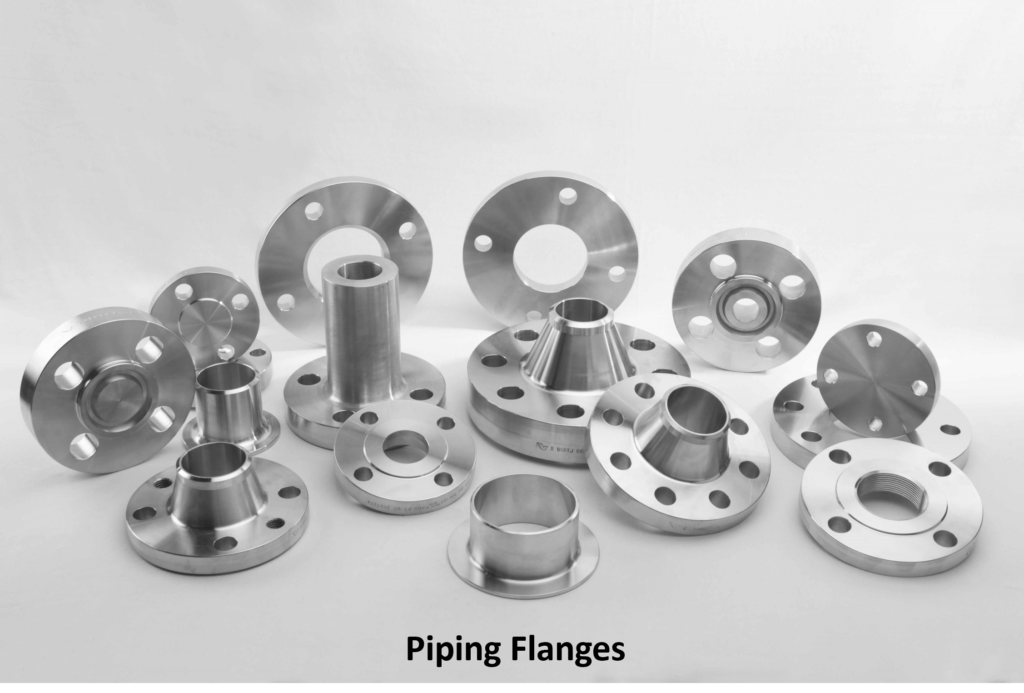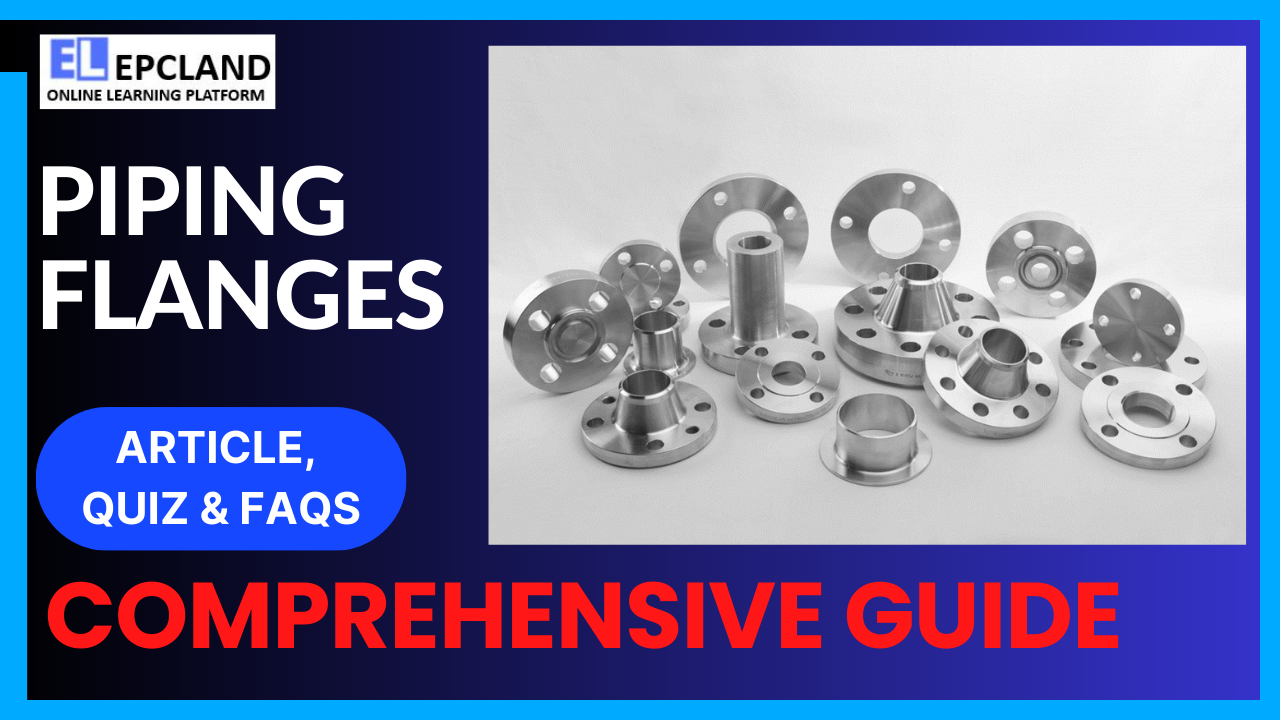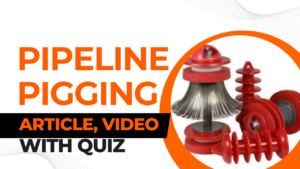I. Introduction
Piping flanges are critical components in the oil and gas industry, playing a vital role in connecting various sections of a pipeline or equipment. These humble yet essential devices are often overlooked but are fundamental to the safety, reliability, and functionality of oil and gas projects. In this article, we will delve into the world of piping flanges, exploring their history, functions, types, applications, advantages, disadvantages, and the associated codes and standards that govern their use.
Table of Contents
Don’t miss the Complete Course on Piping Engineering: Check Now
Enrollment Link
II. Brief History
The use of flanges in industrial applications dates back to the early days of the industrial revolution. In the context of oil and gas, flanges became indispensable with the growth of the petroleum industry in the late 19th century. Before the development of standardized flange systems, joining pipes and equipment was a complex and time-consuming task. Flanges revolutionized this process by providing a reliable means of connecting pipes and equipment quickly and securely.
III. Basic Function and Working Principle
1. Function of Piping Flanges
Piping flanges serve two primary functions: they provide a means for joining pipes and equipment together, and they allow for easy disassembly when maintenance or repair is required. These functions are crucial for the efficient operation of oil and gas facilities.
2. Working Principle
The working principle of piping flanges is relatively simple. Two flanges are bolted together with a gasket placed between them. When the bolts are tightened, the gasket creates a tight seal, preventing leaks. This connection can be easily disassembled by removing the bolts, making it possible to access and service the components within the pipeline or equipment.
IV. Types of Piping Flanges
Piping flanges come in various types, each designed for specific applications and conditions. The most common types include:

1. Weld Neck Flanges
Description: Weld neck flanges, also known as WN flanges, are one of the most common types of flanges used in high-pressure applications. They have a long, tapered hub, which serves several purposes. The extended hub provides excellent reinforcement to the joint, making it suitable for high-pressure systems. The tapered design also reduces stress concentration at the base of the flange.
Applications: Weld neck flanges are often used in critical locations where structural integrity is paramount. They are commonly found in pressure vessels, heat exchangers, and pipeline connections where high-pressure and high-temperature conditions are prevalent.
Advantages:
- Excellent structural integrity and resistance to high pressures.
- Reduced stress concentration due to the tapered hub design.
- Reliable and durable connections for critical applications.
Disadvantages:
- Welding is required for installation, which can be labor-intensive and time-consuming.
- May not be suitable for applications where frequent disassembly is needed.
2. Slip-On Flanges
Description: Slip-on flanges are characterized by their ease of installation. They have a slightly larger bore than the outside diameter of the pipe, allowing them to slip over the pipe end. These flanges typically have a raised face and are attached to the pipe with fillet welding on both the inside and outside of the flange.
Applications: Slip-on flanges are commonly used in low-pressure and non-critical applications. They are suitable for systems where frequent disassembly is not required.
Advantages:
- Easy to align and install, reducing labor costs.
- Suitable for low-pressure systems and applications where welding is acceptable.
- Lower cost compared to some other flange types.
Disadvantages:
- Not as strong as weld neck flanges, making them unsuitable for high-pressure systems.
- Welded connections may be vulnerable to corrosion and leaks over time.
3. Blind Flanges
Description: Blind flanges are solid disks with no bore or opening in the center. They are used to seal the end of a pipe, valve, or pressure vessel. Blind flanges are typically bolted to the mating flange or equipment using through-bolts.
Applications: Blind flanges are essential for isolating sections of piping systems or equipment during maintenance, inspection, or repair. They are also used as closure devices in pressure vessels and tanks.
Advantages:
- Effective in closing off pipelines, preventing the flow of fluids.
- Ideal for maintenance and isolation purposes.
- Available in a wide range of materials to suit various applications.
Disadvantages:
- Limited to the function of sealing and isolation, not for connecting pipes.
- Requires proper gasket selection and bolt tightening to ensure a tight seal.
4. Socket Weld Flanges
Description: Socket weld flanges have a socket or recess into which the pipe is inserted. They are then fillet-welded on the outside to create a strong, leak-resistant connection. The socket provides additional support for the pipe, enhancing structural integrity.
Applications: Socket weld flanges are commonly used in high-pressure systems where pipe size is relatively small. They are favored in applications where a smooth bore and strong joint are required.
Advantages:
- Strong and reliable joint with good structural support.
- Suitable for high-pressure and high-temperature applications.
- Smooth bore reduces turbulence and pressure drop in the pipeline.
Disadvantages:
- Requires welding, which may complicate disassembly and maintenance.
- Not suitable for large-diameter pipes due to socket size limitations.
5. Threaded Flanges
Description: Threaded flanges have threads on the inner bore, allowing them to be screwed onto the pipe end. They are typically used in low-pressure systems where welding is not desirable. Threaded connections provide ease of assembly and disassembly.
Applications: Threaded flanges are commonly used in smaller diameter pipes and low-pressure applications, such as plumbing and instrumentation systems.
Advantages:
- Easy to install and disassemble without welding.
- Suitable for small-diameter pipes and non-critical systems.
- Cost-effective solution for low-pressure applications.
Disadvantages:
- Limited to low-pressure applications due to the threaded connection.
- Threads may wear over time, requiring periodic inspection and maintenance.
Understanding the different types of piping flanges and their characteristics is crucial for selecting the right flange for a specific oil and gas industry project, ensuring safety, efficiency, and reliability.
V. Applications of Piping Flanges
Piping flanges are ubiquitous in the oil and gas industry, and their versatile nature makes them indispensable across various applications. Here are some of the primary applications where piping flanges play a crucial role:
1. Pipeline Construction
One of the most common and critical applications of piping flanges in the oil and gas industry is in pipeline construction. Pipelines are the arteries of the industry, transporting crude oil, natural gas, and other fluids over vast distances. Flanges are used extensively to connect different sections of pipe, valves, pumps, and other equipment.
Role: Piping flanges facilitate the assembly of pipelines by providing secure and leak-free connections. They allow for easy disassembly when maintenance or repairs are required, minimizing downtime.
2. Pressure Vessels
In refineries, petrochemical plants, and other facilities, pressure vessels are used to store and process various fluids under high pressure and temperature conditions. Piping flanges are crucial components in these vessels.
Role: Flanges in pressure vessels ensure the integrity of the equipment. They allow for the attachment of pipes, nozzles, and manways, and they must maintain a reliable seal to prevent leaks in these high-pressure environments.
3. Wellheads
In the upstream sector of the oil and gas industry, wellheads are essential components that control the flow of hydrocarbons from underground reservoirs to the surface. Flanges are integral to wellhead equipment.
Role: Wellheads use flanges to connect casing and tubing strings to the surface equipment. These connections must withstand extremely high pressures, making the reliability of flanges critical for safety and operational efficiency.
Don’t miss the Complete Course on Piping Engineering: Check Now
Enrollment Link
4. Heat Exchangers
Heat exchangers are employed in refineries and processing plants to transfer heat between two fluids without them coming into direct contact. Flanges are vital for the assembly and operation of these devices.
Role: Flanges secure the tubes to tube sheets in heat exchangers, creating sealed chambers for the exchange of heat. Reliable flange connections are essential for maintaining efficient heat transfer.
5. Offshore Platforms
Offshore oil and gas production platforms face unique challenges due to their harsh marine environments. Piping flanges are extensively used in these platforms for various purposes.
Role: Flanges are employed in offshore platforms to connect pipes, risers, and other equipment. They must withstand corrosion from saltwater exposure and provide dependable connections for the safety of personnel and equipment.
6. Chemical Processing
The chemical processing industry relies on a wide range of fluids and materials for various chemical reactions. Piping flanges are essential for connecting the intricate network of pipes and equipment used in chemical plants.
Role: Flanges in chemical processing plants ensure the secure and leak-free transport of chemicals and maintain the integrity of the overall system, preventing hazardous leaks.
7. LNG Terminals
Liquefied Natural Gas (LNG) terminals are crucial for the storage and transportation of natural gas in a condensed form. Flanges are used in various components of LNG facilities.
Role: Flanges connect pipes, valves, and equipment in LNG terminals, ensuring the safe and efficient transfer of LNG between storage tanks, transport vessels, and distribution networks.
8. Refineries
Refineries are complex facilities where crude oil is processed into various refined products. Flanges are employed throughout refineries, connecting pipes and equipment in numerous processes.
Role: Flanges enable the assembly of the intricate piping systems within refineries, including those for distillation, cracking, and other refining processes. They are critical for maintaining safety and preventing leaks in these high-temperature and high-pressure environments.
VI. Advantages & Disadvantages
Advantages of Piping Flanges
| Advantage | Explanation |
|---|---|
| Versatility | Flanges are adaptable and can be used in a wide range of applications. |
| Ease of Maintenance | Flanged connections allow for easy disassembly and access to equipment. |
| Leak Resistance | Properly installed flanges provide a reliable seal, minimizing leaks. |
| Modularity | Flanged connections make it easier to modify and expand piping systems. |
| Standardization | Industry standards ensure compatibility and reliability. |
Disadvantages of Piping Flanges
| Disadvantage | Explanation |
|---|---|
| Cost | Flanges and associated hardware can be expensive. |
| Space Requirement | The use of flanges can increase the space required for piping systems. |
| Vulnerable to Misalignment | Improper alignment during installation can lead to leaks. |
| Gasket Wear | Gaskets may wear over time and require periodic replacement. |
| Corrosion Potential | Flanges are susceptible to corrosion in harsh environments. |
VII. Associated Codes & Standards
The use of piping flanges in the oil and gas industry is governed by a range of codes and standards to ensure safety, reliability, and compliance. Some of the most important codes and standards include:
1. ASME B16.5
ASME B16.5, titled “Pipe Flanges and Flanged Fittings,” is a widely recognized standard that covers dimensions, tolerances, materials, marking, and testing requirements for pipe flanges and flanged fittings.
2. API 6A
API 6A, titled “Specification for Wellhead and Christmas Tree Equipment,” provides standards for flanges used in oil and gas wellhead and Christmas tree equipment. It ensures the reliability and integrity of these critical components.
3. ANSI/ASME B31.3
ANSI/ASME B31.3 is part of the ASME B31 series and covers process piping. It includes guidelines for the design, construction, and inspection of piping systems, including flanged connections.
4. NACE MR0175/ISO 15156
NACE MR0175/ISO 15156 specifies requirements for materials used in oil and gas production in environments containing H2S (sour service). It includes guidelines for the selection of flange materials to prevent sulfide stress cracking.
VIII. Conclusion
In conclusion, piping flanges are unsung heroes in the world of oil and gas industry projects. They may seem like simple components, but their importance cannot be overstated. From their historical role in revolutionizing industrial connections to their modern applications in complex pipeline systems and pressure vessels, piping flanges are vital for the safety, reliability, and efficiency of oil and gas operations. Understanding the types, advantages, disadvantages, and adherence to industry standards is crucial for successful project execution in this dynamic industry. Whether hidden within a pipeline or proudly on display in a refinery, piping flanges remain indispensable to the oil and gas sector’s continued success.
FAQs
1. What is the primary function of piping flanges in the oil and gas industry?
Piping flanges primarily serve two functions in the oil and gas industry. First, they provide a secure and leak-resistant means of connecting pipes and equipment together. Second, they allow for easy disassembly, making maintenance, repairs, and modifications more convenient.
2. What are the common types of piping flanges used in the industry, and how do they differ?
Common types of piping flanges include weld neck, slip-on, blind, socket weld, and threaded flanges. These types differ in their design and application. For instance, weld neck flanges are suitable for high-pressure applications, while slip-on flanges are easier to align and install.
3. Are there specific standards and codes that govern the use of piping flanges in oil and gas projects?
Yes, there are industry-specific standards and codes that govern the use of piping flanges. Some of the key standards include ASME B16.5, API 6A, ANSI/ASME B31.3, and NACE MR0175/ISO 15156. These standards ensure the safety, reliability, and compliance of flanged connections in various applications.
4. What are the advantages of using piping flanges in oil and gas projects?
Piping flanges offer several advantages, including versatility in applications, ease of maintenance, leak resistance, modularity for system modifications, and adherence to industry standards. These benefits contribute to the overall efficiency and reliability of oil and gas operations.
5. Are there any drawbacks or challenges associated with the use of piping flanges in the industry?
While piping flanges provide numerous benefits, they also come with challenges. These include the cost of flanges and associated hardware, the space required for flanged connections, the need for precise alignment during installation to prevent leaks, the periodic replacement of gaskets, and susceptibility to corrosion in harsh environments. Understanding and addressing these challenges are essential for successful project execution.
Recommended courses (Published on EPCLand)
- Basics of Piping Engineering
- Piping Layout Engineering
- Piping Material Engineering
- Piping Stress Analysis
- Complete Course on Piping Engineering
- Material Requisitions
- Piping Material Specifications
- Valve Material Specifications
Don’t miss the published articles on following:
Don’t miss the Complete Course on Piping Engineering: Check Now
Enrollment Link
Attempt Quiz
Question 1:
What is the primary purpose of using flanges in oil & gas piping systems?
Explanation: Flanges in oil & gas piping systems are primarily used to allow easy assembly and disassembly of pipes, facilitating maintenance and modifications.
Question 2:
Which type of flange is commonly used for connecting pipes of different sizes in an oil & gas project?
Explanation: Slip-On Flanges are commonly used for connecting pipes of different sizes in oil & gas projects due to their versatility.
Question 3:
Which flange face type is suitable for applications where leakage is not acceptable in oil & gas systems?
Explanation: The Ring Type Joint (RTJ) flange face type is suitable for applications where leakage is not acceptable in oil & gas systems.
Question 4:
Which material is commonly used for manufacturing flanges in corrosive oil & gas environments?
Explanation: Stainless Steel is commonly used for manufacturing flanges in corrosive oil & gas environments due to its corrosion resistance.
Question 5:
What is the purpose of flange gaskets in oil & gas piping systems?
Explanation: Flange gaskets are used to create a leak-tight seal between flange faces in oil & gas piping systems.
Question 6:
Which flange type is often used for high-pressure applications in oil & gas pipelines?
Explanation: Weld Neck Flanges are often used for high-pressure applications in oil & gas pipelines due to their strength and reliability.
Question 7:
Which flange connection type allows for easy alignment of bolt holes during installation?
Explanation: Lap Joint Flanges allow for easy alignment of bolt holes during installation in oil & gas systems.
Question 8:
What is the primary advantage of using a Blind Flange in an oil & gas pipeline?
Explanation: The primary advantage of using a Blind Flange is temporary pipe closure or isolation in oil & gas pipelines.
Question 9:
Which flange standard is commonly followed in the oil & gas industry for specifying flange dimensions and materials?
Explanation: API 6A is commonly followed in the oil & gas industry for specifying flange dimensions and materials.
Question 10:
Which type of flange is designed to allow the insertion of a pipe or valve into the flange assembly?
Explanation: Lap Joint Flanges are designed to allow the insertion of a pipe or valve into the flange assembly in oil & gas applications.



